The Best Classic Cocktails To Serve At Your Afternoon Tea
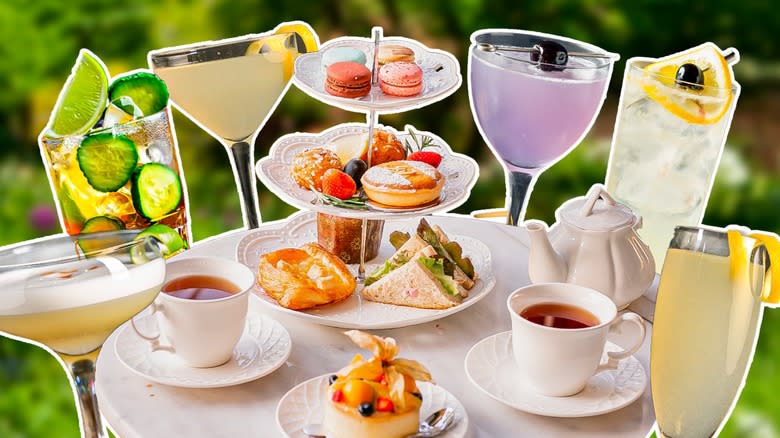
- Oops!Something went wrong.Please try again later.
On a warm, sunny summer afternoon, a steaming cup of tea in an ornate ceramic cup is a lot less appealing than a cold, refreshing sipper. Hang up some wind chimes, iron the doilies, and forget about putting the kettle on. It's happy hour at afternoon tea, and we're passing up the Earl Grey for something a little more ... spirited. We've rounded up the best classic cocktails to elevate your afternoon tea party to sipping stardom. Don't blame us if you never go back to chamomile. Cue the gentle tinkle-bell intro music from "The Great British Bake Off."
Spoiler alert: There's going to be a lot of gin. Something about that juniper-berry-forward, potent-yet-pleasant spirit feels oh-so-right in the floral, sophisticated atmosphere of the tea table. We've showcased a few fun opportunities for fresh flower garnishes, too (hello, hostess envy and nature-focused flair). And, for afternoons when you awake to find you've slept until 2:00 p.m. following an eventful night out, we've taken the liberty of arranging this lineup of tea-party-worthy classic cocktails in ascending order of strength.
Read more: 23 Cocktails To Try If You Like Drinking Gin
Pimm's Cup
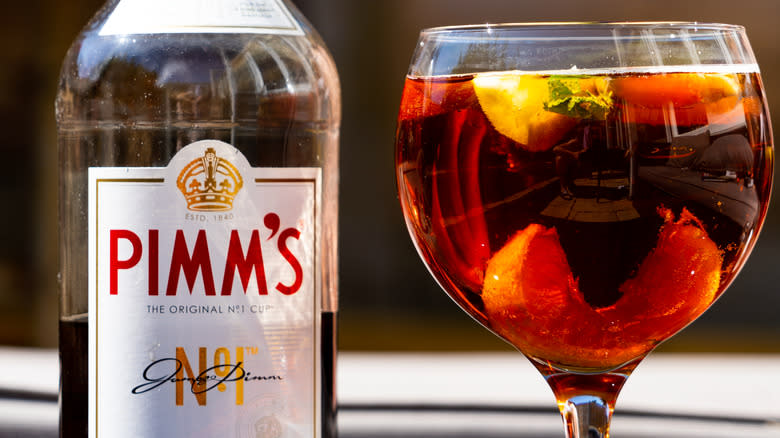
The classic Pimm's Cup cocktail just sounds like it belongs on an English tea spread. It's the signature cocktail of Wimbledon, England's annual world-famous tennis tournament. Luckily, the teatime appeal of this refreshing bevy extends beyond just the name.
Perhaps unsurprisingly, the drink originated in London during the 1840s, and fans first praised it as a medicinal tonic — although, it's really no mystery why with its combination of ginger ale, lemon juice, and cucumber. The name comes from the cocktail's chief ingredient Pimm's No. 1, a gin-based liqueur made from botanicals, citrus, and spices for an herbaceous, bittersweet taste.
To assemble a Pimm's Cup, Pimm's No. 1 and lemon juice are stirred together in the bottom of an ice-filled highball glass or wide stemmed cocktail glass, then topped with the ginger ale and gently stirred together to combine. This thirst-quencher is acidic, sharp, and slightly spiced, yet refreshing. Some folks swap the ginger ale for lemon-lime soda, or equal parts lemonade and ginger beer. Choose your own adventure. Garnish with fresh mint leaves, a whole strawberry, and a magenta hibiscus flower.
The liqueur is the only alcoholic ingredient in this one, so the Pimm's Cup clocks in at an ultra-tame 5.3% ABV, about the same as one White Claw hard seltzer. As you assemble your tea spread, pair this ginger-cucumber sipper with snacks that lean more savory, like fennel and orange scones or tea sandwiches with onion cream cheese and smoked salmon.
Tom Collins
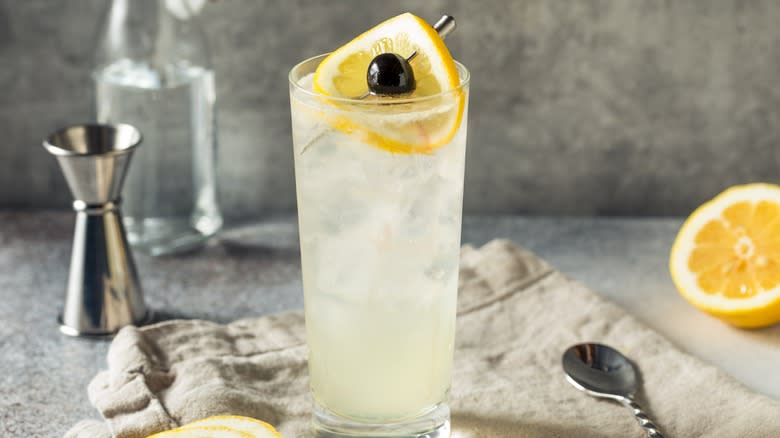
It would seem inappropriate to talk about afternoon cocktails without mentioning good old gin and lemonade, aka the Tom Collins. The now-classic cocktail may have originated as a prank (more on that here), but it has earned a reputation of downright sophistication and accessibility over the years, and it belongs on your afternoon tea table.
To make it, Old Tom gin (not to be confused with London Dry or Plymouth gin), freshly squeezed lemon juice, and simple syrup are wet-shaken and strained into an ice-filled Collins glass. The botanical, sweet-sour sipper clocks in at 13.35% ABV. This one is wicked fun to customize. We're all about the Meyer Lemon Tom Collins, as the Meyer lemons add a naturally sweeter flavor for a cocktail that's light and pleasant. For an herbaceous flair and impressive aesthetic appeal, garnish your Tom Collins with a long sprig of fresh rosemary.
Or, you could swap the Old Tom gin for Empress 1908 Elderflower Rose Gin (roughly $45 at liquor stores in New York City). Its rose top notes on the nose and palate make for an aromatic pink drink tailor-made for a tea party. If you forego the rosemary sprig, garnish your Tom Collins with a maraschino cherry trio skewer and an edible flower. Golden calendulas and pink dianthus would be especially pretty against the lemon yellow.
French 75
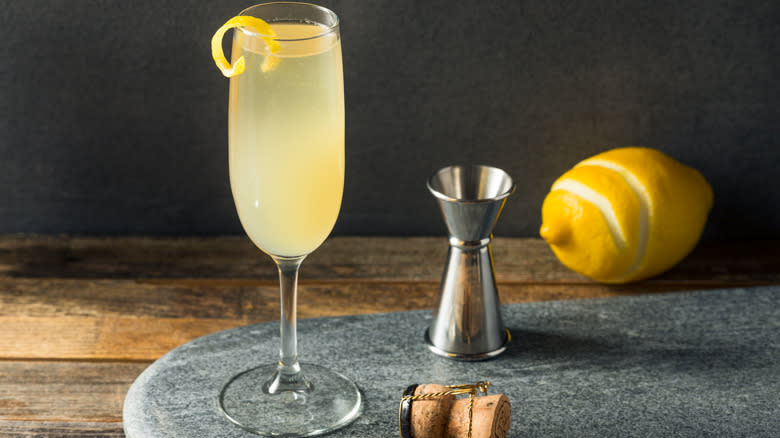
The French 75 is essentially fancy jungle juice: Gin and champagne. Or, alternatively, the mimosa's cool older sister who studied abroad and smokes hand-rolled cigarettes now. With its botanical bite and effervescent mouthfeel, the French 75 is deceptively potent for its delicate presentation and texture (do not be deceived).
This impressive, impactful sipper is an homage to the eponymous 75 millimeter field gun used by the French army during World War I. This particular model emerged as a symbol of hope and victory for the French and American people. In "The Savoy Cocktail Book," Harry Craddock wrote that the cocktail "hits with remarkable precision," via Difford's Guide.
To assemble, the gin, fresh lemon juice, and simple syrup are wet-shaken until thoroughly chilled, then poured into a flute glass and topped with chilled champagne. It's fresh, clean, and packs a respectable 16.45% ABV. This one also makes a great brunch cocktail for impressing guests or hair-of-the-dogging-it in style.
In such a stripped-down drink, quality ingredients count. Opt for a mid-level gin here. Brut champagne is traditional, but you can steer the profile sweeter or dryer with your choice of bubbly. Garnish with a lemon twist on the rim and a sprig of fresh lavender. To complete the tea party, pair with buttermilk blackberry scones and mini almond cakes.
Pisco Sour
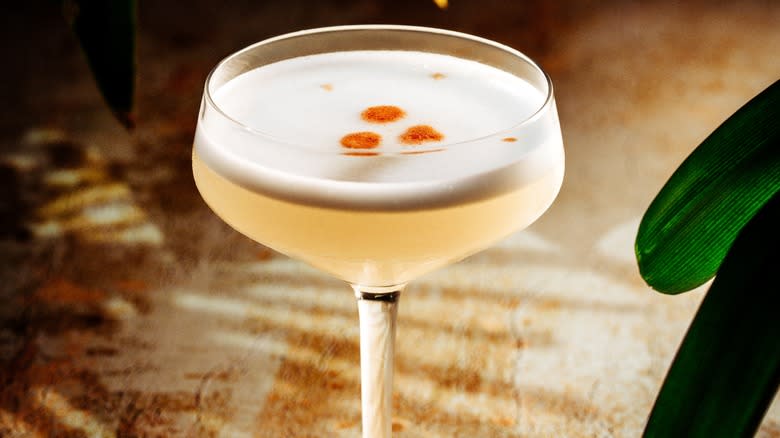
The Pisco Sour is a bright, sweet-tart blend of pisco, lime juice, Angostura bitters, and frothy egg white. If you've never worked with it before, pisco is a Peruvian (or possibly Chilean, it's the source of some contentious debate) made from distilled grapes, technically a form of brandy, and toting a botanical, bittersweet profile. The egg white foam cap adds a rich texture and silky mouthfeel, perfect for a luxurious afternoon tea.
To assemble a Pisco Sour, the pisco, lime juice, simple syrup, and egg white are vigorously dry-shaken until the egg white begins to froth and stiffen up. The mixture is then wet-shaken and strained into a chilled Nick & Nora glass (or an ice-filled rocks glass) and topped with three symmetrical drops of Angostura bitters, which leave distinct dark spots in the white foamy head. For a vegan-friendly afternoon tea, you can swap the egg white for aquafaba.
Some folks also add a splash of orange blossom water into the mix for a little floral brightness. This sipper packs a roughly 16.84% ABV, but might be slightly stronger if you omit the orange blossom water. Garnish with a large, bright orange daylily or peppery, scarlet nasturtium flowers, and pair with umami-creamy tea snacks like goat cheese deviled eggs, asparagus crostini, and classic cucumber cream cheese finger sandwiches.
Corpse Reviver No. 2
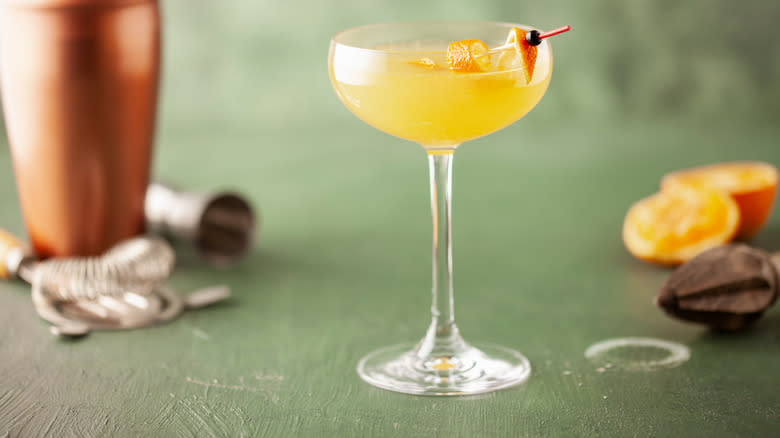
The Corpse Reviver No. 2 (not to be confused with the Corpse Reviver No. 1) is a gin cocktail that gets its name from bringing the dead back to life -- aka curing a hangover with a stiff drink. While the science behind it is shaky at best, it's a method that works, and if it ain't broke, don't fix it. Legendary bartender Harry Craddock was serving up Corpse Reviver No. 2s at the original Savoy Hotel in London during the early 1900s, and as other classic cocktails have evolved over time, modern mixologists are making their Corpse Reviver No. 2s the same way as first recorded in Craddock's "The Savoy Cocktail Book," published in 1930.
To assemble, equal parts London dry gin, triple sec, Lillet Blanc, lemon juice, simple syrup, and a few dashes of absinthe are wet-shaken and strained into a chilled coupe glass. Alternate preparations rinse the glass with absinthe rather than add it into the drink. This Prohibition-era staple is all about balance, especially with its higher 19.6% ABV. The zesty, acidic lemon meets herbaceous, anise-tinged absinthe and citrusy triple sec for a drink that's punchy yet tart and refreshing. Garnish with a lemon twist and fresh chamomile flowers (which also look adorable in a glass of iced tea) or delicate white pea blossoms. Serve your Corpse Reviver No. 2 with lemon blueberry scones and pistachio muffins.
Aviation
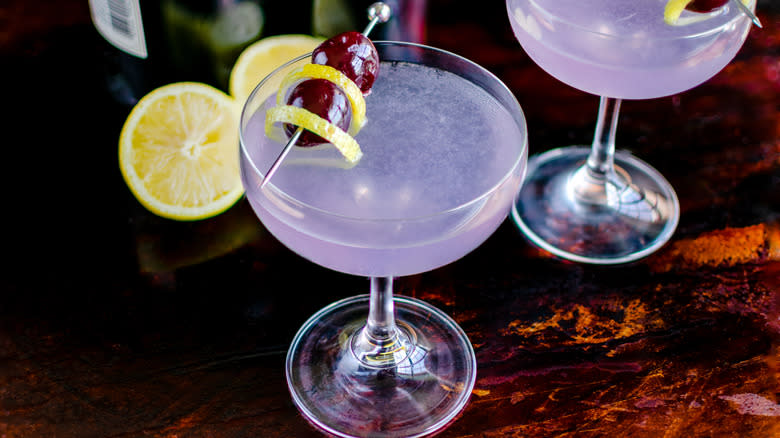
The Aviation cocktail is arguably one of the most sophisticated, delicate, tea-party-worthy cocktails ever created. It's the bold, violet-hued beauty with the tasting profile of a garden. Crème de violet and Luxardo cherry come together for a dimensional botanical cocktail that's simultaneously floral, sweet, and slightly bitter -- much like a flower.
To make it, dry gin, maraschino liqueur (typically Luxardo brand), crème de violette, and lemon juice are wet-shaken and fine-strained into a chilled coupe glass. It may invoke a mental image of lovely flower petals, but it packs a not-to-be-dismissed 23.41% ABV. Garnish with a candied lemon twist, a brandied cherry, and fresh lilac, violets, or borage flowers.
This complex sipper is a particularly apt fit for your afternoon tea, because thanks to its violet-forward flavor, the classic Aviation's largest hamartia is that it's infamously tough to pair with food. Skip the entree and pair this purple punch with strawberry cream cheese finger sandwiches and apricot scones.
Read the original article on Tasting Table

